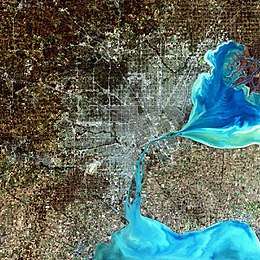Detroit Zoo
The Detroit Zoo is a zoo located in Royal Oak and Huntington Woods, Michigan, about 2 miles (3.2 km) north of the Detroit city limits, at the intersection of Woodward Avenue, 10 Mile Road, and Interstate 696. It is operated by the Detroit Zoological Society (DZS), a non-profit organization, along with the Belle Isle Nature Center, located within the city limits of Detroit on Belle Isle. The Detroit Zoo is one of Michigan's largest family attractions, hosting more than 1.5 million visitors annually.[7][8][9] Situated on 125 acres of naturalistic exhibits, it is home to more than 2,400 animals representing 235 species.[8] The Detroit Zoo was the first zoo in the United States to use barless exhibits extensively.
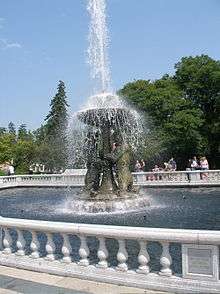 The Horace Rackham Memorial Fountain by Corrado Parducci, in 2007. | |
| Date opened | 1883; August 1, 1928 |
|---|---|
| Location | Huntington Woods/Royal Oak, Michigan, U.S. |
| Coordinates | 42°28′37″N 83°09′25″W |
| Land area | 125 acres (51 ha)[1] |
| No. of animals | 2,000+ |
| No. of species | 245+ |
| Annual visitors | 1,560,981 (2017)[2] |
| Memberships | AZA,[3] AAM,[4] WAZA[5] |
| Major exhibits | Arctic Ring of Life, Australian Outback Adventure, Cotton Family Wolf Wilderness, Great Apes of Harambee, Holden Reptile Conservation Center, National Amphibian Conservation Center, Polk Penguin Conservation Center, Matilda Wilson Free-Flight Aviary |
| Website | www |
Detroit Zoological Park | |
  | |
| Location | 8450 West Ten Mile Road, Huntington Woods/Royal Oak, Michigan |
| Architect | Arthur A. Shurtleff, Heinrich Hagenbeck |
| NRHP reference No. | 90001226[6] |
| Added to NRHP | August 24, 1990 |
History
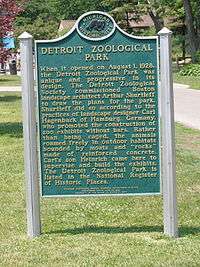
The first Detroit Zoo opened in 1883 on Michigan and Trumbull Avenues (area south of Michigan bounded by Church Street and west of 10th Street (then known as Wesley Street)), across from the then site of Tiger Stadium. William Cameron Coup's circus had arrived in town, only to succumb to financial difficulties. Luther Beecher, a local businessman, financed the purchase of the circus animals and erected a building for their display called the Detroit Zoological Garden. The zoo closed the following year and the building was converted into a horse auction site (the Michigan Avenue Horse Exchange).[10]
The Detroit Zoological Society was founded in 1911, but the zoo's official opening did not occur until August 1, 1928. At the opening ceremony, acting Mayor John C. Nagel was to speak to the gathered crowd. Arriving late, Nagel parked his car behind the bear dens and as he came rushing around the front, Morris, a polar bear, leaped from his moat and stood directly in front of Nagel. Unaware how precarious his situation was, Nagel stuck out his hand and walked toward the polar bear joking, "He's the reception committee." The keepers rushed the bear and forced him back into the moat, leaving the mayor uninjured.[11]
By 1930, the Bear Dens and Sheep Rock had been added, followed shortly by the Bird House. Next to be constructed were the Elk Exhibit, the Baboon Rock, and Primate and Reptile houses. The Detroit Zoo was the first zoo in America with cage-less exhibits.[12]
The onset of the Great Depression brought to a halt additional major projects, but expansion resumed in the 1940s and has periodically continued since then. During the depression, one of the more popular attractions was Jo Mendi, a four-year-old chimpanzee purchased by the zoo director with his own funds. A veteran of Broadway and motion pictures, the chimp performed an act for the audience. As one press account stated, "he enjoys every minute of the act...He counts his fingers, dresses, laces his shoes, straps up his overalls; pours tea and drinks it; eats with a spoon, dances and waves farewell to his admirers." When the chimp fell ill in late 1932 after eating a penny, surgeons from area hospitals came to check him out. During his recovery, visitors brought toys, peanuts and more than $500 worth of flowers, along with several thousands cards and letters. Jo died in 1934 from hoof and mouth disease.[11]
In 1939, sculptor Corrado Parducci created the Horace Rackham Memorial Fountain, popularly known as "the Bear Fountain." The memorial was one of four major donations made by Mary Rackham in the memory of her late husband Horace, the other three being college buildings named after him in Detroit, Ann Arbor and Ypsilanti, Michigan. From the 1950s through the early 1970s, local weatherman Sonny Eliot hosted a television program, At the Zoo, that was shown on Saturdays on television station WDIV.[13]
Until 1982, trained chimpanzees performed for visitors, but the act was discontinued at the insistence of animal rights activists. Also in 1982, the zoo began to charge an admission fee for the first time.[14]
The Arctic Ring of Life, one of North America's largest polar bear habitats, opened to the public in 2001.[15][16] The Arctic Ring of Life is centered on a 300,000 gallon aquarium. The exhibit allows visitors to view the polar bears and seals from a 70-foot (21 m)long underwater tunnel. The tunnel is 12 feet (3.7 m) wide by 8 feet (2.4 m) tall and is made of four-inch (10.1 cm) thick clear acrylic walls that provide a 360-degree view into the aquarium above.[17][18] Other new buildings include the Ruth Roby Glancy Animal Health Complex (opened 2004) and the 38,000-square-foot (3,500 m2) Ford Education Center (opened 2005) which offers school and youth group programs as well as having a theater and exhibit space.
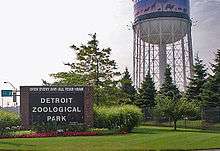
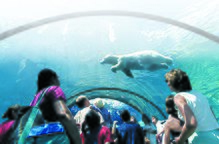
The zoo made additional news in 2005 when it became the first U.S. zoo to no longer keep elephants on ethical grounds,[19] claiming the Michigan winters were too harsh for the animals and that confining them to the elephant house during cold months was psychologically stressful. The elephants, named Wanda and Winky, were relocated to the Performing Animal Welfare Society's (PAWS) sanctuary in San Andreas, California.[20] The zoo had housed elephants since its opening. Former Detroit Zoo elephant Winky died in April 2008 at the PAWS sanctuary; Wanda died there in February 2015.[21] The former elephant exhibit was renovated, and is now home to two white rhinoceros, Jasiri and Tamba.[22]
The Australian Outback Adventure opened in spring 2006, allowing visitors to walk through a 2-acre (0.81 ha) simulated Outback containing red kangaroos and red-necked wallabies. Nothing separates visitors from the marsupials, allowing the animals to hop freely onto the walking path.[23]
On February 18, 2006, the Detroit City Council voted to shut down the zoo as part of budget cuts, being unable to reach an agreement with the Detroit Zoological Society to take over the park and a legislative grant having expired that day. An uproar ensued and the Council, on March 1, 2006, voted to transfer operations to the Detroit Zoological Society with a promised $4 million grant from the Michigan Legislature. The city retained ownership of the assets, including the Detroit Zoo in Royal Oak and the Belle Isle Nature Center in Detroit. The Society is responsible for governance, management and operations, including creating a plan to raise the money needed to keep the facilities operating for generations to come. On August 5, 2008 voters in Macomb, Oakland, and Wayne counties overwhelmingly passed a zoo tax that provides long-term sustainable funding to supplement earned revenue and philanthropic support.
The Penguinarium was temporarily renamed the "Winguinarium" in 2009 while the Detroit Red Wings played the Pittsburgh Penguins in the 2009 NHL Stanley Cup Final.
In 2011, the lions received a home makeover, which includes more than double the room to roam, new landscaping and a glass wall for a much closer encounter with visitors. The Detroit Zoo also has the Simulator Ride, as well as a 4-D Theater, plus the Tauber Family Railroad and a carousel.
In 2013, the zoo celebrated their single largest donation ever ($10 million) by announcing plans for the Polk Penguin Conservation Center (PPCC) which opened in 2016.[24] The penguin center replaces the Penguinarium (which itself was revolutionary when it was built in 1968) and became the largest facility on Earth dedicated to the study of penguins. The Penguinarium is planned to be converted into event space.[25]
In 2017, a biodigester was installed to convert manure and food waste into methane, which is then used to power the zoo's animal hospital.[26]
In September 2019, the Polk Penguin Conservation Center was closed for repairs. It will reopen in the fall of 2020. The penguins have been moved back to the original Penguinarium until the Polk Center reopens.
On July 6, 2019, the zoo celebrated the birth of Keti, a red panda cub, born after a 4-month gestation period.[27]
Mammals
- Aardvark
- Giant anteater
- Ring-tailed lemur
- Japanese macaque
- Western lowland gorilla
- Chimpanzee
- Black-tailed prairie dog
- North American river otter
- North American beaver
- Hoffman's two-toed sloth
- Straw-coloured fruit bat
- African lion
- Amur tiger
- Grizzly bear
- Polar bear
- Gray seal
- Arctic fox
- Gray wolf
- Wolverine
- Red panda
- Miniature donkey
- Grevy's zebra
- Blue wildebeest
- Southern white rhinoceros
- Warthog
- Bactrian camel
- Common eland
- Fallow deer
- Reticulated giraffe
- American bison
- Domestic yak
- Belted Galloway Steer
- Domestic horse
- Shetland sheep
- Pot-bellied pig
- Large black pig
- Gloucestershire Old Spot pig
- Red kangaroo
- Red-necked wallaby
.jpg) Bactrian camels
Bactrian camels Red kangaroo
Red kangaroo Ring-tailed lemur
Ring-tailed lemur_at_the_Detroit_Zoo.jpg) African lion
African lion Western lowland gorilla
Western lowland gorilla White rhinoceros
White rhinoceros_at_the_Detroit_Zoo.jpg) Warthog
Warthog_at_dzs.jpg) Common eland
Common eland Chimpanzees
Chimpanzees American bison
American bison Gray wolf
Gray wolf Grevy's zebras
Grevy's zebras
Birds
- European white stork
- Laughing Kookaburra
- African spoonbill
- Greater flamingo
- Chilean flamingo
- King penguin
- Gentoo penguin
- Rockhopper penguin
- Macaroni penguin
- Common peafowl (Peacock)
- Grey-crowned crane
- Mallard
- Wood duck
- Bald eagle
- Ruppell's vulture
- Lappet-faced vulture
- Cinereous vulture
- Hooded vulture
- Somali ostrich
- Pink-backed pelican
- Barn owl
- Domestic fowl (chicken)
- Scarlet ibis
- Bleeding-heart dove
- Jambu fruit dove
- Boat-billed heron
- Blue-bellied roller
- Taveta golden weaver
- Emerald starling
- Snowy-crowned robin-chat
- Yellow-crowned bishop
- Hooded pitta
- Red-billed leiothrix
- Pygmy goose
- Nicobar pigeon
- spur-winged plover
- Green heron
- Black crake
- Speckled mousebird
- Oriole warbler
_at_DZS.jpg) Laughing kookaburra
Laughing kookaburra Bald eagle
Bald eagle Chilean flamingo
Chilean flamingo Pink-backed pelicans
Pink-backed pelicans.jpg) Saddle-billed stork
Saddle-billed stork.jpg) Ostrich
Ostrich Crowned crane
Crowned crane
Reptiles
- Bushmaster
- Madagascar giant hognose snake
- Green tree python
- African spurred tortoise
- Indian star tortoise
- Egyptian tortoise
- Dwarf caiman
- Chinese alligator
- Water monitor
- Pig-nosed turtle
- West African gaboon viper
- San Esteban chuckwalla
- Rhinoceros ratsnake
- bowsprit tortoise
- Argentine snake-necked turtle
- Mata mata
- Black iguana
- Shingle-backed skink
- Pancake tortoise
- Beaded lizard
- Uromastyx
- European legless lizard
- Timor python
- Armenian viper
- Mexican lance-headed rattlesnake
- Pacific pond turtle
 Chinese alligator
Chinese alligator Cuvier's dwarf caiman
Cuvier's dwarf caiman Shingle-back skink
Shingle-back skink Gaboon viper
Gaboon viper Sonoran iguana
Sonoran iguana.jpg) The reticulated python
The reticulated python.jpg) Water monitor
Water monitor
Amphibians
- Puerto Rican crested toad
- Panamanian golden frog
- Red-eyed tree frog
- Poison dart frog
- Asian painted toad
- Japanese giant salamander
- Dwarf siren
- Hellbender
- Eastern red-spotted newt
- Amazon milk frog
- Tiger salamander
- Emperor newt
- Mississippi gopher frog
- Mexican leaf frog
- Crawfish frog
- Malayan horned frog
- Mantella
- Mountain chicken frog
- Wyoming toad
- Caecilian
- African clawed frog
- Mudpuppy
- Axolotl
 Panamanian golden frog
Panamanian golden frog_at_Dzs.jpg) Golden mantellas
Golden mantellas.jpg) Poison dart frog
Poison dart frog Japanese giant salamander
Japanese giant salamander Hellbender
Hellbender
Habitats
National Amphibian Conservation Center
The National Amphibian Conservation Center is a $7 million, 12,000-square-foot facility situated on a two-acre Michigan wetland area and pond called "Amphibiville". The center, which opened in June 2000, has a diverse range of frogs, toads, salamanders, newts and caecilians. The Wall Street Journal dubbed the attraction "Disneyland for toads".[28] The National Amphibian Conservation Center participates in research and conservation efforts for species including the Panamanian golden frog, Puerto Rican crested toad, and Wyoming toad.
In 2002, the Detroit Zoo was awarded the AZA National Exhibit Award for Amphibiville.[29]
The Arctic Ring of Life
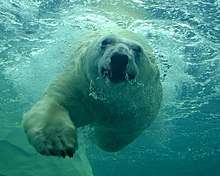
The 4-acre Arctic Ring of Life, which opened in October 2001, is home to three polar bears, gray seals, a harbor seal and arctic foxes. It is among the largest polar bear habitats in North American zoos.
In 2003, the Detroit Zoo was awarded the AZA Significant Achievement Award for the Arctic Ring of Life.[29]
Cotton Family Wetlands and Boardwalk
Mimicking a Michigan ecosystem, the 1.7-acre pond and wetlands area and accompanying 7,200-square-foot boardwalk is home to native fish, frogs, turtles and birds as well as the zoo's trumpeter swans. The boardwalk itself is made from a 95-percent recycled wood-alternative decking material called Trex, composed primarily of plastic grocery bags and reclaimed hardwood. The Wetlands and Boardwalk are bounded by Amphibiville, the Warchol Beaver Habitat, the Edward Mardigian Sr. River Otter Habitat, and the Holden Reptile Conservation Center.
Thanks to a $102,350 grant from NOAA, the Wetlands are also able to be used as professional development and outdoor classroom for teachers and students underrepresented in science fields.[30]
Cotton Family Wolf Wilderness
The Cotton Family Wolf Wilderness is a $1.4 million two-acre sanctuary that features native meadows and trees, a flowing stream and pond, dens, and elevated rock outcroppings from which two gray wolves survey their surroundings. The habitat also incorporates a renovated historic log cabin which had existed on the property.[31]
Giraffe Encounter
At the Giraffe Encounter, guests are able to feed the giraffes from an 18-foot-tall platform that extends into their habitat. This experience, which started in July 2007, runs Tuesday through Sunday from spring through fall.
The Great Apes of Harambee
The Great Apes of Harambee is a 4-acre indoor/outdoor habitat home to chimpanzees and western lowland gorillas. The animals may be rotated into each other's habitat spaces, as this simulates nomadic movement similar to wild behavior.[32]
Holden Reptile Conservation Center
Opened as the Holden Museum of Living Reptiles in 1960, the Holden Reptile Conservation Center is home to 150 reptiles representing 70 species, 45 percent of which are considered threatened or endangered in the wild.
Edward Mardigian Sr. River Otter Habitat
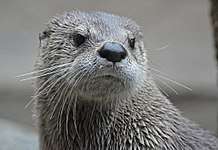
The Edward Mardigian Sr. River Otter Habitat provides a habitat for North American river otters and features a 9,000-gallon pool complete with waterfall and waterslide. The pool is enclosed on one side by a glass wall, on the other side of which is an observation building. The habitat is designed so that visitors – including small children – can enjoy an eye-level view of the otters as they swim.[33]
Polk Penguin Conservation Center
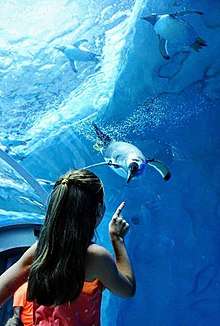
The Polk Penguin Conservation Center (PPCC), opened in April 2016. The Polk Penguin Conservation Center is the largest center for penguins in the world and was awarded the 2017 Exhibit Award by the Association of Zoos and Aquariums, given annually to accredited zoos and aquariums for excellence in exhibit design.
The PPCC is closed for waterproofing repairs as 9 gallons of groundwater had been seeping into the building daily, requiring pumping. The Detroit Zoological Society entered into arbitration with the original builders of the PPCC, Detroit based DeMaria Building Co. and Florida based Wharton-Smith Inc. to rectify the problem. After winning arbitration, executive director and CEO Ron Kagan has faulted the joint venture DeMaria/Wharton-Smith for its knowingly failure to properly waterproof the foundation and its failure to inform the D.Z.S. thereafter.[34] Through mediation the joint venture Demaria/Wharton-Smith agreed to make necessary repairs at their own expense and have attributed faulty work to subcontractors. The joint venture maintains they are "proud of the quality of work provided to the D.Z.S. over the past two decades", citing numerous awards for their work on the PPCC. During the exhibit closure, the penguins that reside in the PPCC will move back to the original Penguinarium. The Polk Penguin Conservation Center is set to reopen in the fall of 2020 after repairs are complete.[35][34]
Jane and Frank Warchol Beaver Habitat
Opened in 2013, the Jane and Frank Warchol Beaver Habitat abuts the Cotton Family Wetlands, and is home to nine beavers. As beavers are nocturnal, their night-time activities are recorded and played throughout the day on televisions in the exhibit. This is the first time beavers have been on display at the Detroit Zoo since 1969.
The Wildlife Interpretive Gallery
The Wildlife Interpretive Gallery is home to the Butterfly Garden, Matilda Wilson Free-Flight Aviary, Science On a Sphere, as well as DZS's permanent fine art collection.[36] Shelle Isle, an exhibit dedicated to the partula snail – a once-extinct animal the DZS is credited with saving.
Other highlights
Among other highlights at the Detroit Zoo are the Horace H. Rackham Memorial Fountain, the 2 ft (610 mm) narrow gauge Tauber Family Railroad, the Carousel, and the Ford Education Center which houses the Simulator Ride and 4-D Theater.[37]
Detroit Zoological Society
The Detroit Zoological Society (DZS) is a non-profit organization that operates the Detroit Zoo and Belle Isle Nature Center. Its $44.5 million annual operating budget is supported by earned revenue, philanthropic support, and a tri-county (Macomb, Oakland, and Wayne) millage. The organization has 260 full and part-time employees, more than 52,000 member households, and more than 1,000 volunteers.[8]
Delivering on its mission of "Celebrating and Saving Wildlife", the DZS is a leader in animal conservation and welfare. In collaboration with the DNR and USFWS, the DZS continues to release Zoo-reared federally endangered Karner blue butterflies in their natural habitats in Michigan with the goal of reestablishing self-sustaining populations. Each summer, DZS bird keepers assist with conservation efforts in northern Michigan for the federally endangered Great Lakes piping plover by artificially incubating abandoned piping plover eggs. Most recently, the DZS, in collaboration with the Detroit River International Wildlife Refuge and the Detroit Water and Sewerage Department, established of a common tern nesting site on Belle Isle.[38]
The Detroit Zoological Society is frequently asked to help with the rescue of exotic animals from private owners, pseudo-sanctuaries, roadside zoos, and circuses. Among the DZS's rescues are more than 1,000 exotic animals confiscated from an animal wholesaler in Texas, a polar bear that was confiscated from a circus in Puerto Rico, a lioness that was used to guard a crack house, and retired racehorses. In addition, the Detroit Zoological Society and Michigan Humane Society, in collaboration with dozens of local animal welfare organizations, host Meet Your Best Friend at the Zoo, the nation's largest offsite companion animal adoption program. Since the event's inception in 1993, more than 25,000 dogs, cats, and rabbits have been placed into new homes at the spring and fall events.[39]
The Center for Zoo and Aquarium Animal Welfare and Ethics (CZAAWE) was created in 2009 as a resource center for captive exotic animal welfare knowledge and best practices. It provides a much-needed forum for exotic animal welfare policy discussion/debate and recognizes captive exotic animal welfare initiatives through awards.[40]
The DZS provides educational experiences to nearly 70,000 teachers and students annually through camps, curriculum-based field trips, family and youth programs and professional development opportunities. The DZS also supports students and teachers through conservation education in rural rainforest communities through the Adopt-A-School program. The Berman Academy for Humane Education offers a broad range of unique and engaging programs that help people help animals. The Academy utilizes a variety of teaching strategies – from traditional instruction to storytelling, role-playing, theater, and virtual technology – to educate audiences about the need to treat other living creatures with empathy, respect and gentleness.[41]
Accredited by the Association of Zoos & Aquariums,[3] the Detroit Zoo features many award-winning habitats including the Wildlife Interpretive Gallery, National Amphibian Conservation Center, Great Apes of Harambee and Arctic Ring of Life,[8] which was named the number-two best zoo exhibit in the U.S. by the Intrepid Traveler's guide to "America's Best Zoos".
The Simulator Ride is an educational, action-packed thrill ride which offers an exciting you-are-there experience from the comfort of a specially equipped motion-simulated big-screen theater seat. The 126-seat 4-D Theater, the only theater of its kind at any Michigan zoo, delivers a high-definition viewing experience in 3-D with 7.1 digital audio surround sound, enhanced with full-sensory 4-D special effects such as blasts of wind, mist and scents.[42]
The Detroit Zoo is located at the intersection of 10 Mile Road and Woodward Avenue in Royal Oak, Mich.[43] It is open daily 9 a.m. to 5 p.m. April through Labor Day (until 8 p.m. Wednesdays and Thursdays during July and August), 10 a.m. to 5 p.m. the day after Labor Day through October and 10 a.m. to 4 p.m. November through March (closed only on Thanksgiving, Christmas and New Year's Day).[44] Admission ranges from $13 to $18; children under 2 are free.[38]
Belle Isle Nature Center
The Belle Isle Nature Center sits on a five-acre site surrounded by undisturbed forested wetlands on Belle Isle State Park in Detroit. The facility features indoor animal habitats, a bee exhibit, bird observation window, an outdoor native butterfly garden, outdoor classrooms, nature play area and the Blue Heron Lagoon Nature Trail. It provides year-round educational, recreational and environmental conservation opportunities for the community.
Photo gallery
 Barrier free kangaroo exhibit
Barrier free kangaroo exhibit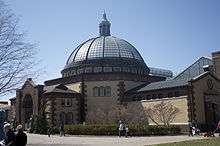 The Wildlife Interpretive Gallery
The Wildlife Interpretive Gallery
Notes
- "Zoo Facts". Detroit Zoo. Retrieved February 21, 2015.
- Nagl, Kurt (January 4, 2018). "More Than 1.5 million Visit Detroit Zoo in 2017, Down Slightly from Record 2016". Crain Communications. Archived from the original on January 5, 2018. Retrieved May 19, 2018.
- "Currently Accredited Zoos and Aquariums". aza.org. AZA. Retrieved February 18, 2011.
- "Find a Museum Member". aam_us.org. AAM. Retrieved May 13, 2015.
- "Zoos and Aquariums of the World". waza.org. WAZA. Retrieved May 13, 2015.
- "National Register Information System". National Register of Historic Places. National Park Service. July 9, 2010.
- "Detroit Zoo Annual Report 2007-2009" (PDF). www
.detroitzoo . Archived from the original (PDF) on May 8, 2012. Retrieved June 26, 2012. External link in.org |website=(help) - "Facts About the Detroit Zoo". Retrieved June 26, 2012.
- "Detroit Zoo Sets New Attendance Record".
- Austin, William (1974). The First Fifty Years. Detroit Zoological Society.
- Houston, Kay (February 24, 1999). "How the Detroit Zoo's first day was almost its last". detnews.com. Detroit News. Archived from the original on January 21, 2013. Retrieved July 9, 2007.
- "Wayne County – A Brief History". Archived from the original on August 26, 2007. Retrieved October 7, 2007.
- "WWJ Newsradio 950 Our Staff". Retrieved October 7, 2007.
- Wonders Among Us: Celebrating 75 Years of the Detroit Zoo. Royal Oak, MI: Detroit Zoological Society. 2003. pp. 91. ISBN 0-615-12418-6.
- PR NEWS WIRE (October 20, 2001). The World's Largest Polar Bear Exhibit Opens at the Detroit Zoo. United Business Media.
- Detroit Zoological Society (2001).
- "Arctic Ring of Life page 1". Archived from the original on June 30, 2007. Retrieved July 5, 2007.
- "Arctic Ring of Life page 2". Archived from the original on July 8, 2007. Retrieved July 5, 2007.
- Zoo sends its elephants packing Detroit Zoo. Retrieved on July 9, 2007.
- Elephants (April 8, 2005).Detroit Free Press.
- Detroit Zoo Elephant Winky Dies, Detroit Zoo, April 7, 2008.
- Rhinos. Detroit Zoological Society. Retrieved on July 9, 2007.
- Outback Adventure Archived April 27, 2007, at the Wayback MachineDetroit Zoological Society. Retrieved on July 9, 2007.
- Polk Penguin Conservation Center http://www.detroitzoo.org/press-releases-2013/10-million-to-support-detroit-zoo-penguin-conservation-center Archived September 25, 2013, at the Wayback Machine
- Bat Conservation Center reference http://www.hourdetroit.com/Hour-Detroit/June-2013/A-Really-Cool-Plan/
- Manuzak, Stephanie (January 7, 2020). "Detroit Zoo turns poo into electricity". Yale Climate Connections. Retrieved January 8, 2020.
- "Red panda cub Keti makes her debut at Detroit Zoo". candgnews.com. Retrieved January 30, 2020.
- "National Amphibian Conservation Center". Archived from the original on May 3, 2012. Retrieved June 26, 2012.
- "Exhibit Award". AZA.org. Association of Zoos and Aquariums. Retrieved May 19, 2015.
- "Under the Boardwalk, a World of Wildlife Awaits". DetroitZoo.org. Detroit Zoological Society. Retrieved May 19, 2015.
- "Detroit Zoo Opens Cotton Family Wolf Wilderness". detroitzoo.org. Detroit Zoological Society. Retrieved July 24, 2015.
- "African Forest". Archived from the original on June 4, 2012. Retrieved June 26, 2012.
- "You Otter See What's New at the Detroit Zoo". DetroitZoo.org. Detroit Zoo. Archived from the original on April 16, 2015. Retrieved May 19, 2015.
- Raven, Benjamin. "Penguins at Detroit Zoo to move for 9-month project to fix 'faulty waterproofing'". Mlive.com. MLive Media Group. Retrieved June 21, 2019.
- Robinson, Elissa. "Detroit Zoo to close penguin center for 9 months due to 'faulty waterproofing'". Freep.Com. Detroit Free Press. Retrieved June 21, 2019.
- "The Wildlife Interpretive Gallery". Archived from the original on June 4, 2012. Retrieved June 26, 2012.
- "Attractions". Archived from the original on June 21, 2012. Retrieved June 26, 2012.
- "Prices". Retrieved June 26, 2012.
- "Meet Your Best Friend at the Zoo". Retrieved June 26, 2012.
- "CZAW". Retrieved June 26, 2012.
- "Detroit Zoo Education". Retrieved June 26, 2012.
- "Wild Adventure Ride". Retrieved June 26, 2012.
- "Directions to the Zoo". Archived from the original on June 14, 2012. Retrieved June 26, 2012.
- "Hours". Archived from the original on June 14, 2012. Retrieved June 26, 2012.
References and further reading
- Austin, William (1974). The First Fifty Years. The Detroit Zoological Society.
- Detroit Zoological (2003). Wonders Among Us: Celebrating 75 Years of the Detroit Zoo. Detroit Zoological Society. ISBN 0-615-12410-0.
- Fisher, Dale (2003). Building Michigan: A Tribute to Michigan's Construction Industry. Grass Lake, MI: Eyry of the Eagle Publishing. ISBN 1-891143-24-7.
- Rodriguez, Michael and Thomas Featherstone (2003). Detroit's Belle Isle Island Park Gem (Images of America). Arcadia Publishing. ISBN 0-7385-2315-1.
- Kvaran, Einar Einarsson. Shadowing Parducci, unpublished manuscript, Detroit.
External links
| Wikimedia Commons has media related to Detroit Zoo. |
